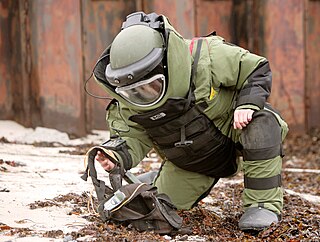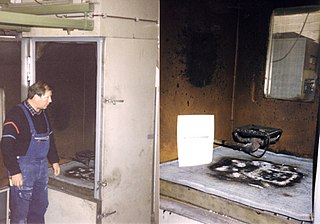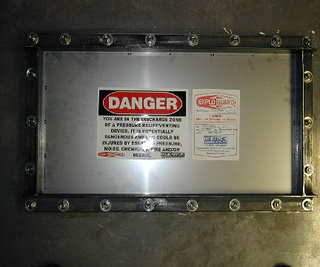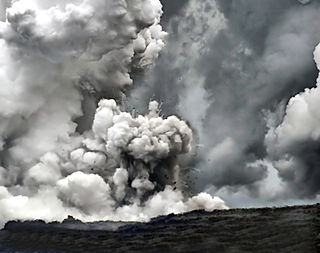 W
WAnti-flash white is a white colour commonly seen on British, Soviet, and U.S. nuclear bombers. The purpose of the colour was to reflect some of the thermal radiation from a nuclear explosion, protecting the aircraft and its occupants.
 W
WA blast damper is used to protect occupants and equipment of a structure against overpressures resultant of an explosion. The blast dampers normally protect air inlets and exhaust penetrations in an otherwise hardened structure. Blast dampers are related or identical to blast valves, the latter name is generally used to describe blast mitigation devices as they relate to nuclear explosions.
 W
WA blasting mat is a mat usually made of sliced-up rubber tires bound together with ropes, cables or chains. They are used during rock blasting to contain the blast, prevent flying rocks and suppress dust.
 W
WA boiler explosion is a catastrophic failure of a boiler. There are two types of boiler explosions. One type is a failure of the pressure parts of the steam and water sides. There can be many different causes, such as failure of the safety valve, corrosion of critical parts of the boiler, or low water level. Corrosion along the edges of lap joints was a common cause of early boiler explosions.
 W
WA bomb suit, Explosive Ordnance Disposal (EOD) suit or a blast suit is a heavy suit of body armor designed to withstand the pressure generated by a bomb and any fragments the bomb may produce. It is usually worn by trained personnel attempting bomb disposal. In contrast to ballistic body armors, which usually focus on protecting the torso and head, a bomb suit must protect all parts of the body, since the dangers posed by a bomb's explosion affect the entire body.
 W
WA combustible material is something that can combust (burn) in air. Flammable materials are combustible materials that ignite easily at ambient temperatures. In other words, a combustible material ignites with some effort and a flammable material catches fire immediately on exposure to flame.
 W
WIn electrical and safety engineering, hazardous locations are places where fire or explosion hazards may exist. Sources of such hazards include gases, vapors, dust, fibers, and flyings, which are combustible or flammable. Electrical equipment installed in such locations could provide an ignition source, due to electrical arcing, or high temperature. Standards and regulations exist to identify such locations, classify the hazards, and design equipment for safe use in such locations.
 W
WAn explosimeter is a gas detector which is used to measure the amount of combustible gases present in a sample. When a percentage of the lower explosive limit (LEL) of an atmosphere is exceeded, an alarm signal on the instrument is activated.
 W
WAn explosion vent or rupture panel is a safety device to protect equipment or buildings against excessive internal, explosion-incurred pressures, by means of pressure relief. An explosion vent will relieve pressure from the instant its opening pressure pstat has been exceeded.
 W
WExplosives safety originated as a formal program in the United States in the aftermath of World War I when several ammunition storage areas were destroyed in a series of mishaps. The most serious occurred at Picatinny Arsenal Ammunition Storage Depot, New Jersey, in July, 1926 when an electrical storm led to fires that caused explosions and widespread destruction. The severe property damage and 19 fatalities led Congress to empower a board of Army and Naval officers to investigate the Picatinny Arsenal disaster and determine if similar conditions existed at other ammunition depots. The board reported in its findings that this mishap could recur, prompting Congress to establish a permanent board of colonels to develop explosives safety standards and ensure compliance beginning in 1928. This organization evolved into the Department of Defense Explosives Safety Board (DDESB) and is chartered in Title 10 of the US Code. The DDESB authors Defense Explosives Safety Regulation (DESR) 6055.9 which establishes the explosives safety standards for the Department of Defense. The DDESB also evaluates scientific data which may adjust those standards, reviews and approves all explosives site plans for new construction, and conducts worldwide visits to locations containing US title munitions. The cardinal principle of explosives safety is expose the minimum number of people for the minimum time to the minimum amount of explosives.
 W
WThe Fire and Blast Information Group (FABIG) is a not-for-profit, membership based organization created in the UK in 1992 in the wake of the Piper Alpha disaster to continue the sharing and dissemination of expert knowledge on fires and explosions arising from the major research projects carried out in the early 1990s.
 W
WThe limiting oxygen concentration (LOC), also known as the minimum oxygen concentration (MOC), is defined as the limiting concentration of oxygen below which combustion is not possible, independent of the concentration of fuel. It is expressed in units of volume percent of oxygen. The LOC varies with pressure and temperature. It is also dependent on the type of inert (non-flammable) gas.
 W
WA steam explosion is an explosion caused by violent boiling or flashing of water into steam, occurring when water is either superheated, rapidly heated by fine hot debris produced within it, or heated by the interaction of molten metals. Pressure vessels, such as pressurized water (nuclear) reactors, that operate above atmospheric pressure can also provide the conditions for a steam explosion. The water changes from a liquid to a gas with extreme speed, increasing dramatically in volume. A steam explosion sprays steam and boiling-hot water and the hot medium that heated it in all directions, creating a danger of scalding and burning.